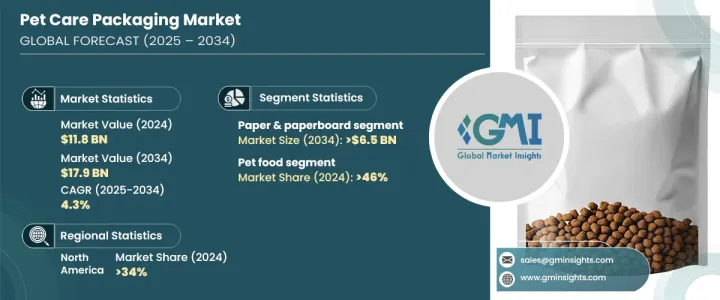
세계의 펫케어 포장 시장은 2024년에 118억 달러로 평가되었으며, 2025년부터 2034년까지 연평균 복합 성장률(CAGR) 4.3%를 나타내 안정적인 성장이 예상되고 있습니다.
이 성장의 주요 요인은 소비자 선호도의 진화, 포장 기술의 첨단화, 환경 친화적이고 지속 가능한 포장 솔루션에 대한 수요의 상당한 증가입니다. 소비자들은 포장재료가 환경에 미치는 영향을 보다 강하게 의식하게 되어, 그것이 업계의 형태를 바꾸고 있습니다. 그 결과 기업은 환경 친화적인 선택을 요구하는 소비자의 기대에 부응하는 혁신적이고 지속 가능한 제품을 제공하는 데 점점 더 많은 노력을 기울이고 있습니다. 시장은 또한 편의성, 기능성, 지속가능성을 보다 중시한 제품 포장 디자인의 변화를 목격하고 있습니다.

펫케어 포장 분야의 가장 중요한 동향 중 하나는 고성능 포장 재료에 대한 수요 증가입니다. 예를 들어, 고기능 필름은 반려동물 식품 포장으로 인기를 끌고 있으며 신선도를 유지하고 향기 유지를 강화하며 제품의 유통 기한을 연장하는 우수한 장벽 특성을 제공합니다. 이 기술은 포장의 전반적인 품질을 향상시킬 뿐만 아니라 지속가능하고 생분해가능한 옵션에 대한 수요 증가에도 대응하고 있습니다. 이에 따라 제조업체는 재활용 가능하고 식물 유래의 대체 포장을 도입하고 책임있는 선택을 요구하는 환경 의식이 높은 소비자에게 호소하고 있습니다.
| 시장 범위 | |
|---|---|
| 시작 연도 | 2024년 |
| 예측 연도 | 2025-2034년 |
| 시작 금액 | 118억 달러 |
| 예측 금액 | 179억 달러 |
| CAGR | 4.3% |
펫케어 포장 시장은 플라스틱, 종이, 판지, 금속 및 기타 4가지 주요 소재 카테고리로 분류됩니다. 종이 및 판지 부문은 CAGR 5.2%를 나타내 눈부신 성장을 이룰 것으로 예상되고 2034년에는 65억 달러에 이를 것으로 전망됩니다. 이 성장에는 재생 가능하고 재활용 가능한 소재에 대한 선호도 증가가 박차를 가하고 있습니다. 보다 많은 소비자가 환경에 미치는 영향을 줄이는 포장을 선호하고 있으며 플라스틱에서 종이 기반 솔루션으로 대폭적인 이동을 촉진하고 있습니다. 지속 가능한 포장에 대한 수요가 증가함에 따라 종이 기반 제품은 환경 의식이 높은 반려동물 소유자에게 선호되는 대체품으로 부상하고 있습니다.
펫케어 포장 시장은 또한 반려동물 식품, 반려동물 장난감과 액세서리, 반려동물 미용 제품, 반려동물 건강과 위생 용품을 포함하여 각종 제품 부문으로 분할됩니다. 반려동물 식품 분야는 2024년 시장 점유율의 46%를 차지했고 앞으로도 계속 성장할 전망입니다. 반려동물의 사육수가 증가하고, 주인이 건강을 중시한 고급 영양을 요구하게 됨에 따라 반려동물 식품 전용 포장 수요가 높아지고 있습니다. 반려동물 식품 포장은 다양한 품종, 라이프 스테이지 및 식사 요구 사항을 충족시켜야 하며, 이는 보호, 기능성 및 소구력이 있는 포장 솔루션의 혁신을 촉구합니다.
2024년 북미는 펫케어 포장 시장의 34%를 차지하며 큰 점유율을 차지했습니다. 미국은 주로 지속가능성을 중시하는 소비자의 영향으로 수요의 견인 역할로서 중심적인 역할을 하고 있습니다. 재활용 가능하고 생분해성 포장으로의 이동은 반려동물 식품, 장난감, 액세서리 분야에서 특히 강합니다. 리실러블 파우치, 싱글 서브 팩, 컴팩트 디자인 등의 편리한 포장 옵션은 기능성을 제공하고 폐기물을 감소시켜 인기를 끌고 있습니다. 소비자 동향의 변화와 환경에 대한 배려로 혁신적이고 지속 가능한 포장 디자인이 보급됨에 따라 펫케어 포장 업계는 지속적인 성장을 이루고 있습니다.
The Global Pet Care Packaging Market was valued at USD 11.8 billion in 2024 and is expected to grow at a steady rate, with a CAGR of 4.3% between 2025 and 2034. This growth is primarily driven by evolving consumer preferences, advances in packaging technology, and a significant rise in the demand for eco-friendly and sustainable packaging solutions. Consumers are becoming more conscious of the environmental impact of packaging materials, which is reshaping the industry. As a result, companies are increasingly focusing on offering innovative, sustainable products that meet consumer expectations for eco-conscious choices. The market is also witnessing a shift in product packaging designs, with more emphasis on convenience, functionality, and sustainability.

One of the most significant trends in the pet care packaging sector is the increasing demand for high-performance packaging materials. For instance, high-performance films are gaining traction in pet food packaging, providing superior barrier properties to preserve freshness, enhance aroma retention, and extend the product's shelf life. This technology is not only improving the overall quality of packaging but is also catering to the growing demand for sustainable and biodegradable options. In response, manufacturers are introducing recyclable and plant-based packaging alternatives, which appeal to the eco-conscious consumer looking for responsible choices.
| Market Scope | |
|---|---|
| Start Year | 2024 |
| Forecast Year | 2025-2034 |
| Start Value | $11.8 Billion |
| Forecast Value | $17.9 Billion |
| CAGR | 4.3% |
The pet care packaging market is categorized into four major material categories: plastic, paper & paperboard, metal, and others. The paper & paperboard segment is set to experience impressive growth, with an expected CAGR of 5.2%, reaching USD 6.5 billion by 2034. This growth is fueled by the increasing preference for renewable and recyclable materials. More consumers are prioritizing packaging that reduces environmental impact, which is encouraging a significant shift from plastic to paper-based solutions. As demand for sustainable packaging rises, paper-based products are emerging as the preferred alternative for environmentally conscious pet owners.
The pet care packaging market is also divided into different product segments, including pet food, pet toys and accessories, pet grooming products, and pet health and hygiene items. The pet food segment accounted for 46% of the market share in 2024 and is poised for continued growth. As pet ownership increases and pet owners seek premium, health-focused nutrition, the demand for specialized pet food packaging grows. Pet food packaging must cater to a variety of breeds, life stages, and dietary needs, which drives the innovation of packaging solutions that are protective, functional, and appealing.
In 2024, North America held a significant share of the pet care packaging market, accounting for 34%. The United States plays a central role in driving demand, largely due to the influence of sustainability-conscious consumers. The shift toward recyclable and biodegradable packaging is particularly strong in the pet food, toys, and accessories segments. Convenient packaging options, such as resealable pouches, single-serve packs, and compact designs, are gaining popularity, offering both functionality and waste reduction. The pet care packaging industry is on track for continued growth as innovative, sustainable packaging designs become more widespread, shaped by changing consumer trends and environmental considerations.